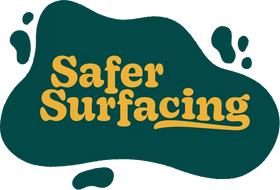
Which safety surface is best for me? Part two – wetpour (1-4mm rubber crumb)
Which safety surface is best for me? Part two – wetpour (1-4mm rubber crumb)
Here at Safer Surfacing we get many enquiries each day from many people from schools, nurseries, councils and the general public. The common theme is that they are enquiring about a safety surface, but are often unsure about the variety of surfaces available to them.
Which surface is best for me?
This is a question that often gets overlooked, so this mini series of blogs is our attempt to explain the different safety surfaces available and to show the benefits and suitability of each one.
Here at Safer Surfacing we manufacture supply and install the following safety surfaces:
- 20mm rubber chipping (this can be loose fill or resin bound)
- Rubber crumb (1-4mm rubber crumb bound with resin, also known as wetpour)
- Rubber mulch (shredded rubber made to look like natural mulch).
We are currently developing a new safety surface (our 10mm chip) and are starting the development of a new product for our equestrian customers also.
All of our range of safety surfacing products are available in 7 colours:
- Green
- Blue
- Plum
- Black
- Terracotta
- Brown
- Grey
What is wetpour?
Safer Surfacing wetpour is a flexible impact attenuating surface made from polyurethane coloured 1-4mm recycled rubber crumb. This is also known as a wearing course, or play surface.
This differs from the traditional EPDM (Ethylene Propylene diene Monomer) which uses virgin rubber and is more expensive than our recycled rubber products.
Wetpour is typically a two-course installation process which can be installed to varying depths, depending on requirement and specification.
Sub-bases
The sub-base (the layer underneath the wetpour surface) can be made from existing tarmac or concrete, or compacted MOT type one stone. A sub-base of rubber can also be used, depending on the depth of wetpour surface required. For clarification of what surface preparation is required please see below. There are essentially three wetpour / surfaces criteria:
- Existing surfaces
- New surfaces for a play surface less than 40mm
- New surfaces for a play surface greater than 40mm.
Wetpour cannot be laid over grass or soil directly.
Existing surfaces
Wetpour can be laid onto existing tarmac or concrete surfaces, as long as they are in reasonable condition and can drain freely. If draining is an issue then bore holes will need to be drilled to allow drainage.
The minimum depth that a wetpour surface (this is also known as the wearing course) can be laid over an existing tarmac or concrete surface is 15mm.
New base surfaces with a wetpour depth of less than 40mm.
If laying a wetpour surface with a depth of 40mm or less, the surface should have a 50mm depth concrete or tarmac sub-base and this should be laid onto a 100mm compacted MOT type 1 sub-base.
New base surfaces with a wetpour depth greater than 40mm.
If your new wetpour surface has a depth greater than 40mm you can lay this directly onto compacted MOT type one stone. The minimum depth of the MOT type one should be 100mm and this depends on the ground condition of the area to be covered.
The overall depth of the play surface can be made up from the wetpour (play surface) course at a minimum depth of 15mm and an SBR (Styrene Butadiene Rubber) to make up the depth required (this can be governed by the critical fall height required).
Wearing course colours
Safer Surfacing advises against using the base black crumb for the wearing course as this is the least light and UV resistant material and can suffer from shrinking and cracking. Using a coloured wetpour is recommended as it effectively reflects back the UV light. Safer Surfacing currently have a 7 colour range and these can be mixed to give a variety of patterns.
- Green
- Brown
- Terracotta
- Plum
- Black
- Grey
- Blue
Edging the perimeter
The perimeter of the wetpour area should be lined with a concrete kerb edge that sits level with the wearing course and the sub-base (this will typically be 150mm in depth). Alternatively you can use a tanalised timber frame. Any edging that sits above the wearing course should be considered as a trip hazard.
Repairing of existing surfaces
If you have an area that requires a repair then this can be carried out successfully. Repairs should never be in black – a coloured 1-4 mm should be used. We also always recommend using a shape such as a circle as sharp corners and joints can be susceptible to shrinking and pulling away.
Due to light exposure it is advisable to use a different colour that contrasts with the existing surface. This is because you will not match the same colour due to wear and tear. You can remove the damaged area and create a pattern or a splash in a different colour.
